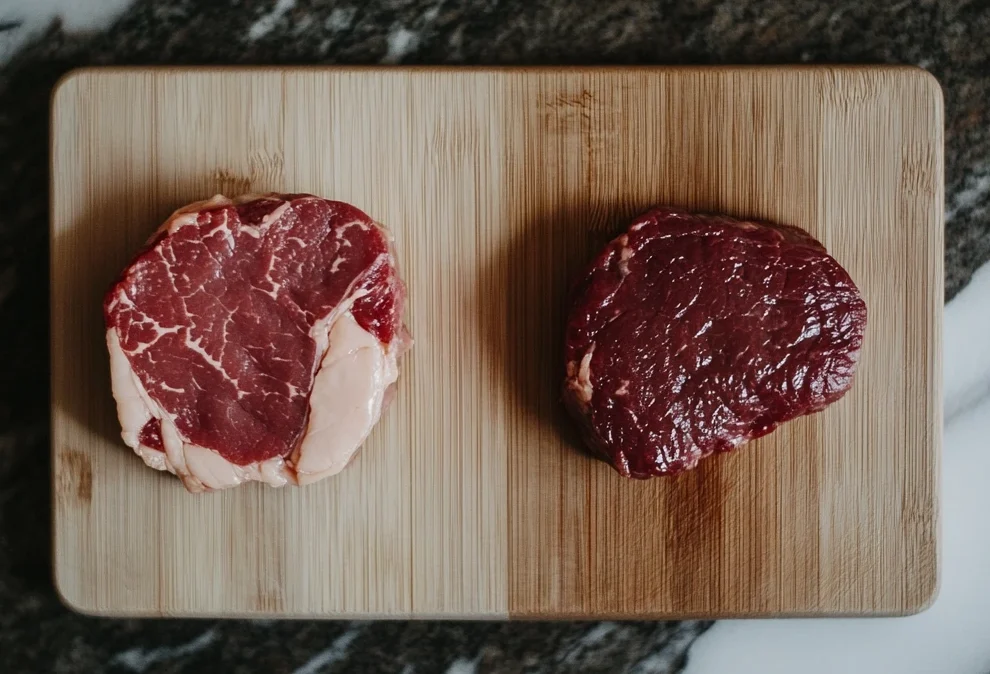Introduction
“Ribeye vs Denver Steak” Ah, the age-old question that tantalizes the taste buds of steak aficionados everywhere: Is Denver Steak better than ribeye? This debate slices through the heart of culinary communities. Each side comes armed with fervent opinions about flavor, texture, and overall dining delight. As we carve into this meaty topic, we’ll explore the nuances that define these beloved beef cuts. They have humble origins. Yet, they’ve risen as staples on dinner plates across the globe. We embark on a flavorful journey. Our goal is not just to discern the differences but also to appreciate what makes each cut uniquely appealing.
Whether you’re a seasoned chef or a curious home cook, this exploration promises a deeper understanding. Perhaps, it will offer a new perspective on these culinary gems. So, sharpen your knives. Let’s delve into the savory world of Denver steak and ribeye. We are unraveling the secrets behind their succulence and savor. For those interested in broadening their culinary skills further, explore our collection of delightful recipes.
Understanding the Cuts
Denver Steak: An Overview
The Denver steak, a relatively recent discovery in the world of beef cuts, has quickly ascended the ranks to become a cherished choice among meat lovers. Extracted from the chuck underblade in the cow’s shoulder, this cut is celebrated for its impressive marbling and profound beefy flavor. Its journey from obscurity to prominence is a testament to the evolving appreciation for every part of the cow, recognizing the unique culinary contributions of each cut.
What sets the Denver steak apart is its exceptional tenderness and robust flavor, ranking it as the fourth most tender cut, trailing just behind the likes of filet mignon, flat iron, and ribeye. This tenderness, coupled with intricate marbling, ensures a succulent flavor that’s simply irresistible. When cooked, the fat within these marbles melts, weaving a richness into the steak that promises not just a taste sensation but a luxuriously satisfying texture.
Ribeye: An Overview
The ribeye cut, on the other hand, is a long-standing favorite among steak enthusiasts. Hailing from the rib section of the cow, this cut is renowned for its rich marbling and deep, meaty flavor. The ribeye’s popularity stems from its perfect balance of fat and lean meat, which renders it exceptionally juicy and flavorful when cooked.
Culinary Comparison
Flavor and Texture
When it comes to the culinary showdown between Denver steak and ribeye, flavor and texture play pivotal roles. The Denver steak, with its rich marbling and beefy essence, offers a tender and flavorful experience. This cut’s unique position in the cow’s shoulder contributes to its deep, concentrated flavor, making it a standout choice for those who cherish both tenderness and taste. The marbling melts during cooking, infusing the steak with a richness that elevates its flavor profile to new heights.
On the flip side, the ribeye boasts a legendary status for its succulent fat content and robust flavor. The marbling in a ribeye is more pronounced than in most other cuts, including the Denver steak, which accounts for its unparalleled juiciness and taste. When cooked, the fat renders down, basting the steak from within and creating a juicy, flavor-packed bite that’s hard to beat. The ribeye’s texture, tender yet slightly chewy, offers a satisfying mouthfeel that’s beloved by steak enthusiasts.
Cooking Techniques
The best cooking methods for each cut can significantly influence their culinary appeal. The Denver steak, due to its tenderness and marbling, excels when cooked using high-heat methods such as grilling or pan-searing. These techniques allow the steak’s natural flavors to shine while achieving a desirable crust on the outside. It’s crucial, however, not to overcook a Denver steak, as its leaner parts can become tough if exposed to heat for too long.
The ribeye, with its higher fat content, is more forgiving and versatile when it comes to cooking methods. Whether you’re grilling, broiling, or pan-searing, the ribeye remains juicy and flavorful. The key to cooking a perfect ribeye lies in managing the fat—allowing it to render and baste the meat, enriching its flavor and maintaining its moisture. For both cuts, allowing the steak to rest after cooking is essential, as it lets the juices redistribute, ensuring every bite is as delicious as the first.

Nutritional and Price Considerations
Nutritional Content
When comparing the Denver steak and ribeye, it’s essential to consider their nutritional profiles. Both cuts offer a rich source of protein, essential for muscle building and repair. However, the ribeye tends to have a higher fat content, including both saturated and monounsaturated fats, due to its pronounced marbling. This can translate to a higher calorie count per serving compared to the Denver steak, which is leaner but still offers a satisfying amount of marbling for flavor.
For those mindful of fat intake, the Denver steak might edge out as the preferable choice. Yet, it’s important to remember that fats contribute to the sensation of fullness and satisfaction after a meal, and they carry fat-soluble vitamins and minerals essential for health. The key is balance and moderation, aligning your choice with dietary preferences and goals.
Price and Value
In terms of cost, the Denver steak often presents a more budget-friendly option without compromising on quality or flavor. Its rise in popularity hasn’t significantly impacted its price, making it an excellent value for those looking to enjoy a premium steak experience at a lower cost. The ribeye, known for its luxurious taste and texture, typically commands a higher price tag, reflective of its coveted status among steak lovers.
Choosing between the Denver steak and ribeye may also depend on the occasion. The ribeye might be your splurge for special celebrations, while the Denver steak could become a go-to for delicious, high-quality meals that won’t break the bank. Ultimately, both cuts offer their unique appeal, whether you’re seeking the ultimate steak indulgence or a high-quality option that offers great taste and value.
Consumer Preferences and Culinary Uses
Consumer Preferences
The debate between Denver steak and ribeye often boils down to personal preference. Some diners prefer the Denver steak for its tender texture and rich flavor, which comes without the ribeye’s higher fat content and price point. Others swear by the ribeye’s juicy, buttery taste, considering it the epitome of steak perfection. Consumer trends show a growing appreciation for lesser-known cuts like the Denver steak, as more people seek out culinary adventures and value-driven choices.
Culinary Uses
Both the Denver steak and ribeye shine across a variety of dishes. The Denver steak’s tenderness and flavor make it ideal for grilling and pan-searing. It’s perfect for a straightforward steak dinner. Or, you can slice it thin for salads and sandwiches. Its versatility also extends to international cuisines. Here, it can be marinated and used in stir-fries or fajitas.
The ribeye boasts rich marbling and deep flavor. It is often the choice for classic steak preparations. You can grill it over an open flame or sear it in a hot pan. This method develops a flavorful crust. The fat content in ribeye renders beautifully. This process creates a succulent, flavorful steak that’s hard to resist. Ribeye also pairs wonderfully with bold sauces and sides. It stands up well to strong flavors.
FAQs
Is Denver steak as tender as ribeye?
While Denver steak is celebrated for its tenderness, ranking impressively among top tender cuts, the ribeye often takes the lead in tenderness due to its rich marbling. The fat content in ribeye not only contributes to its juicy flavor but also to its melt-in-your-mouth texture. However, Denver steak offers a remarkable tenderness that is unmatched by many other cuts, making it a delightful alternative for those seeking a leaner option.
Can Denver steak and ribeye be used interchangeably in recipes?
Yes and no. While both Denver steak and ribeye can be grilled, seared, or broiled, their differing fat contents and textures might affect the outcome of certain recipes. For dishes that rely on the rich juiciness of ribeye, substituting with Denver steak might require adjustments in cooking method or additional ingredients to enhance moisture and flavor. Conversely, in recipes where a leaner cut is preferable, Denver steak shines without significant modifications.
Which cut is better for grilling?
Both cuts excel on the grill, but the choice between Denver steak and ribeye might come down to personal preference and desired outcome. The ribeye’s fat renders beautifully over an open flame, creating a crispy, flavorful exterior and juicy interior. Denver steak, being leaner, benefits from careful attention to avoid overcooking, with its marbling providing enough fat to keep the steak juicy and flavorful. Ultimately, both steaks can produce exceptional results when grilled with care.
Conclusion
The culinary journey from Denver steak to ribeye unveils a rich landscape of flavors, textures, and preferences. Each cut boasts its unique appeal. The Denver steak impresses with its lean tenderness and rich flavor, while the ribeye captivates with its succulent juiciness and luxurious taste. The value and versatility of the Denver steak might attract you, or perhaps the indulgent richness of the ribeye catches your fancy. Both cuts claim their rightful spots in the pantheon of steak excellence.
Choosing between Denver steak and ribeye often rests on personal preference, the occasion, and culinary goals. Whether marking a special occasion or simply spicing up a weeknight dinner, the right steak selection elevates your meal from the ordinary to the extraordinary.
The vast and possibility-filled world of steaks invites experimentation, tasting, and the celebration of culinary and dining pleasures. So, the next time the butcher or grocery store finds you pondering beef cuts, let your knowledge about Denver steak and ribeye guide you. Equipped with this insight and your curiosity, you’ll find it easy to pick the steak that best matches your palate and the occasion. After all, the steak that brings the most joy and satisfaction to your dining table reigns supreme.

